Abstract
Fresh normal rat bile premixed with cholera toxin (CT) did not significantly affect the CT-induced fluid accumulation in rat jejunal ligated loops. Bile from rats intrajejunally (i.j.) immunized three times with CT definitely inhibited CT-induced fluid secretion. Bile duct ligature (BDL) for 1-4 days in unimmunized rats, in contrast with mice, did not significantly affect subsequent CT-elicited fluid secretion in their ligated loops. BDL for 4 days in rats i.j. immunized with CT, only slightly decreased the CT-neutralizing ability of their gut loops. Passive transfer during 24 hr of bile from i.j.-immunized rats, but not from normal rats, into gut of normal recipient rats with BDL, significantly protected loops made in such recipients. The affinity-purified antibodies of immune bile, mixed with CT, neutralized its effect. Our data show that, unlike mice, rat bile acids are not required for expression of the CT effect in gut loops. In addition, bile from i.j.-immunized rats contains enough anti-CT antibodies to be protective on its own, but is not necessary for substantial gut protection against CT in i.j.-immunized BDL rats. Our results confirm a major and complementary role of both biliary and intestinal secretory IgA antibodies in protection of the rat gut mucosa against CT-induced fluid secretion.
Full text
PDF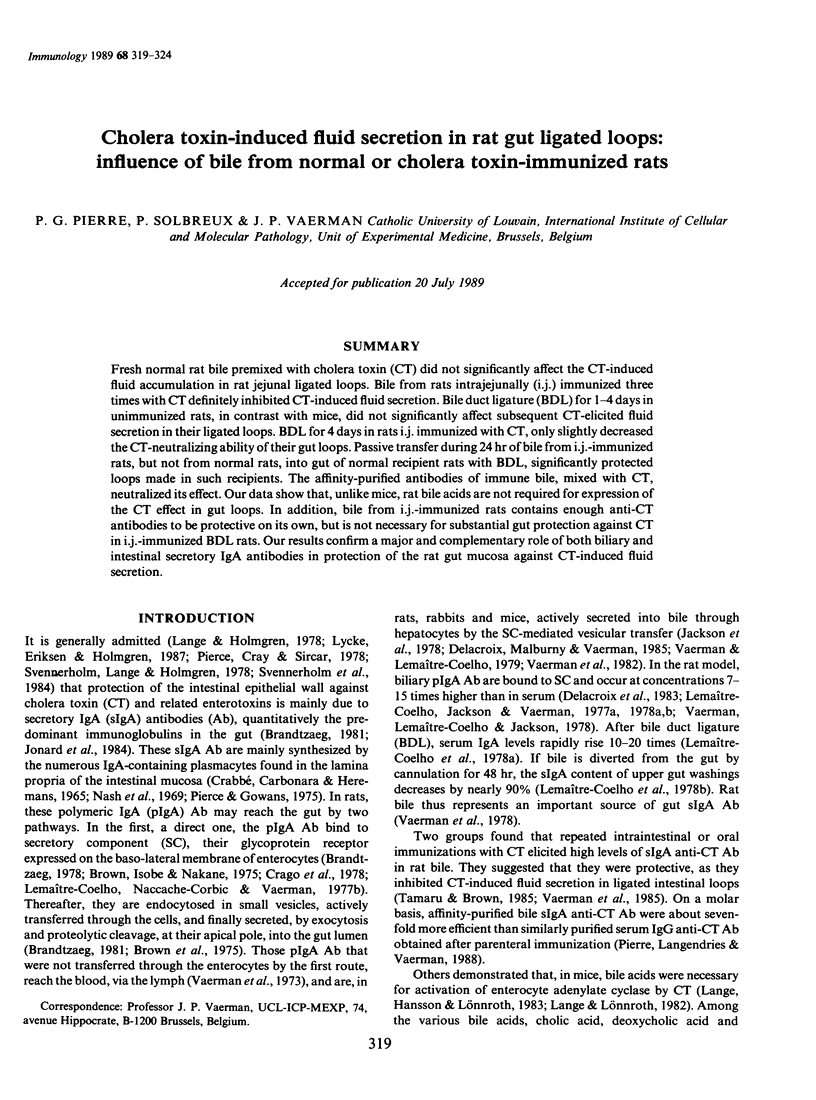
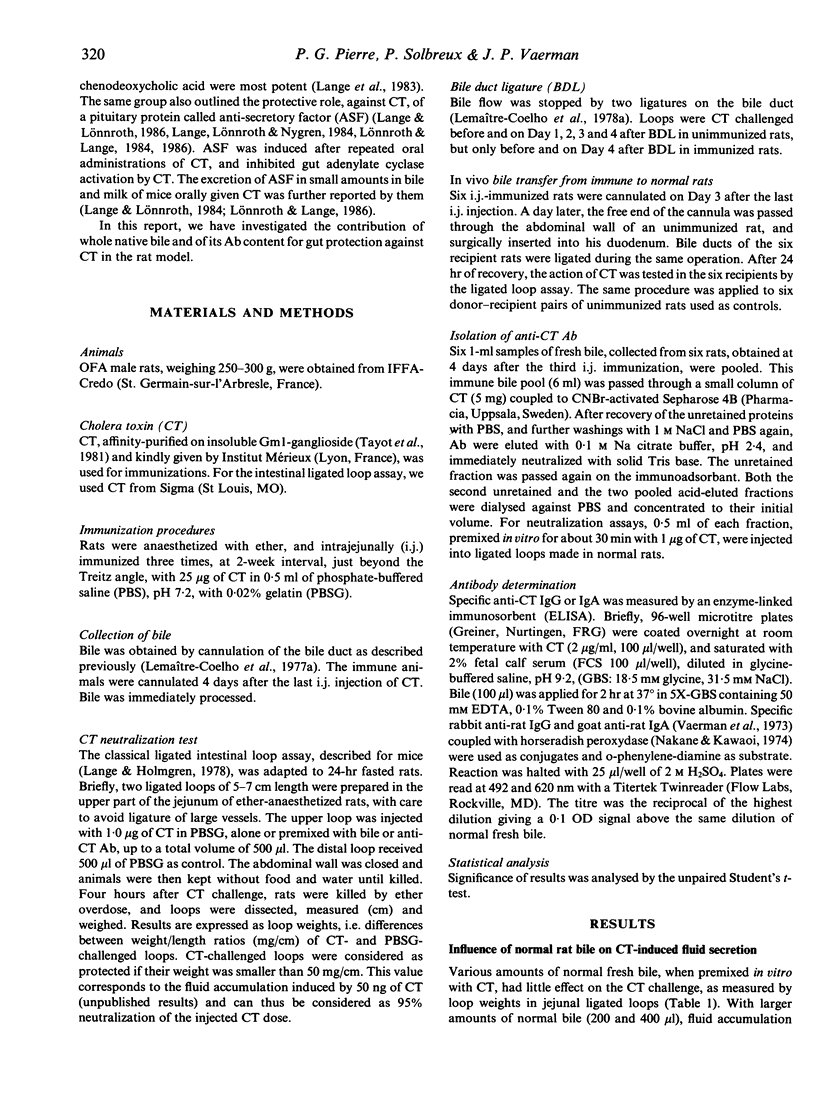
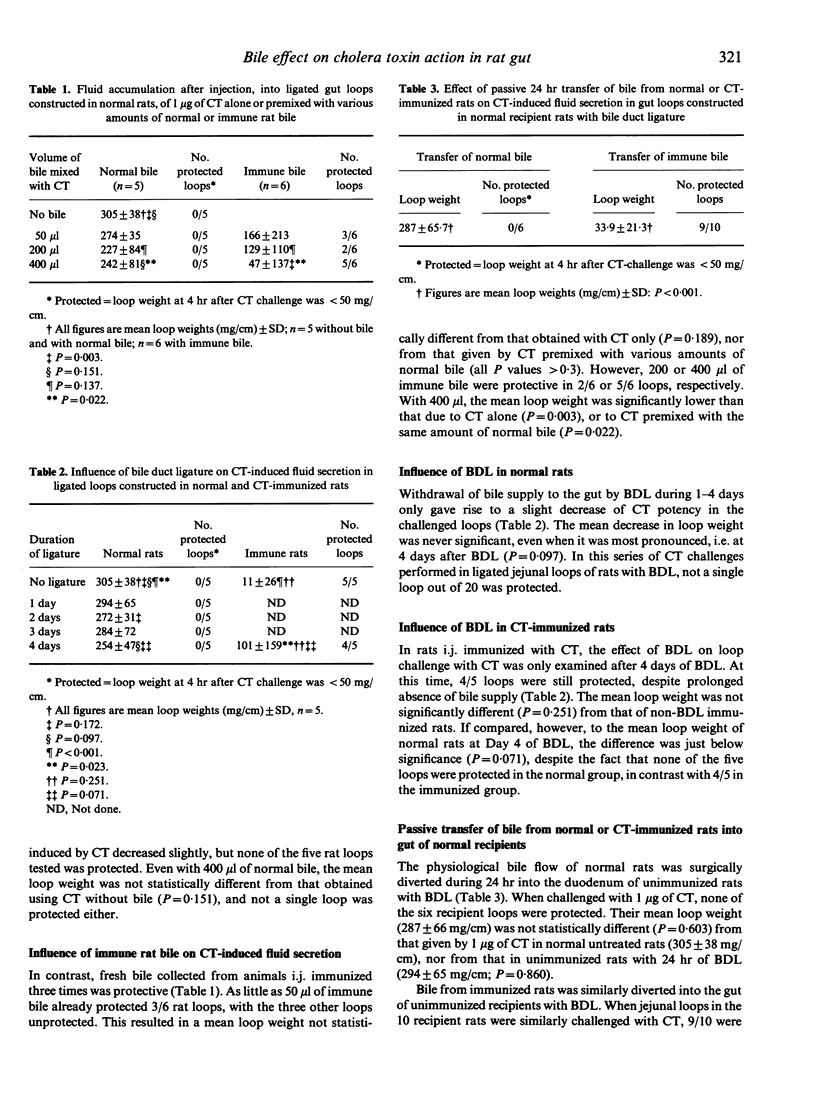
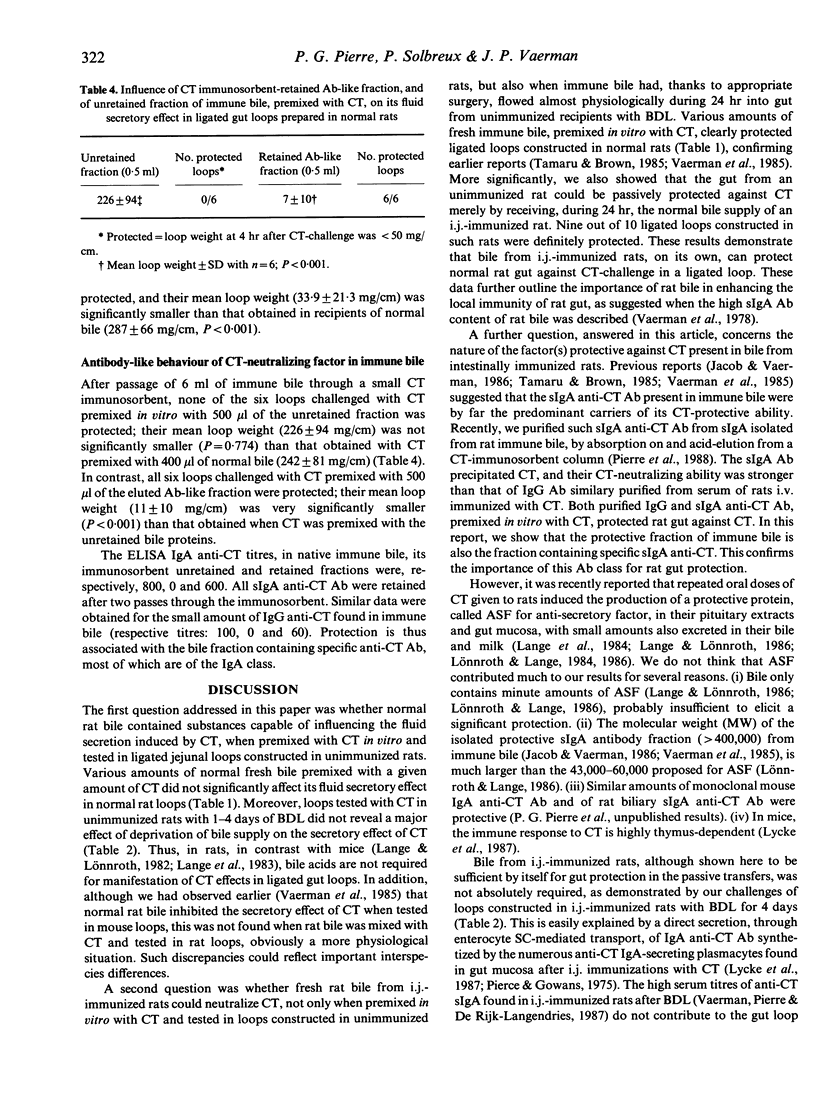
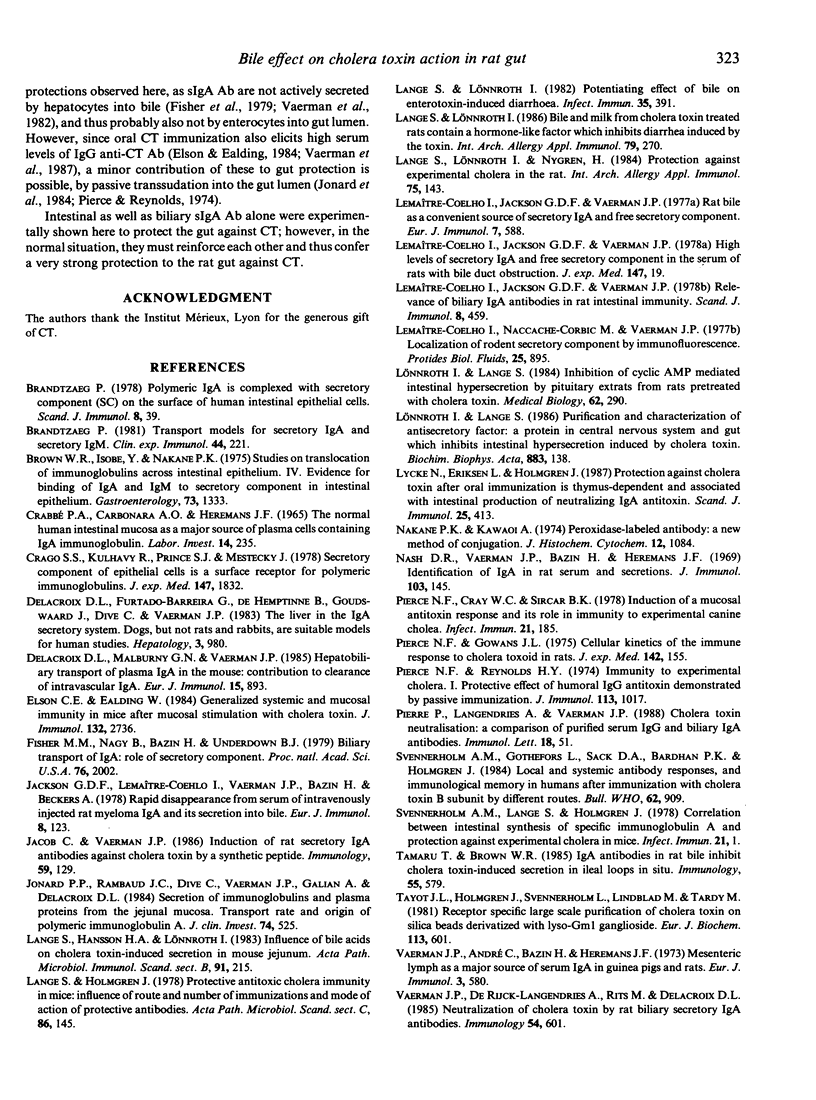
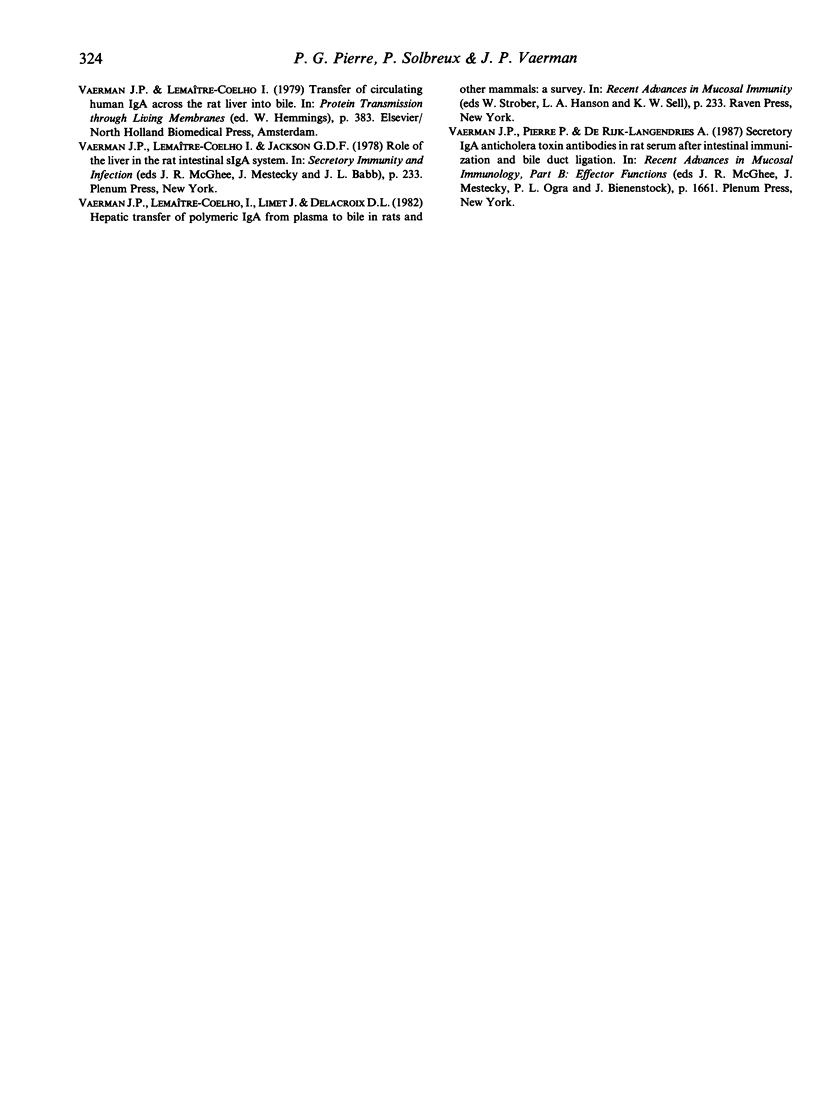
Selected References
These references are in PubMed. This may not be the complete list of references from this article.
- Brandtzaeg P. Polymeric IgA is complexed with secretory component (SC) on the surface of human intestinal epithelial cells. Scand J Immunol. 1978;8(1):39–52. doi: 10.1111/j.1365-3083.1978.tb00494.x. [DOI] [PubMed] [Google Scholar]
- Brandtzaeg P. Transport models for secretory IgA and secretory IgM. Clin Exp Immunol. 1981 May;44(2):221–232. [PMC free article] [PubMed] [Google Scholar]
- Brown W. R., Isobe K., Nakane P. K., Pacini B. Studies on translocation of immunoglobulins across intestinal epithelium. IV. Evidence for binding of IgA and IgM to secretory component in intestinal epithelium. Gastroenterology. 1977 Dec;73(6):1333–1339. [PubMed] [Google Scholar]
- CRABBE P. A., CARBONARA A. O., HEREMANS J. F. THE NORMAL HUMAN INTESTINAL MUCOSA AS A MAJOR SOURCE OF PLASMA CELLS CONTAINING GAMMA-A-IMMUNOGLOBULIN. Lab Invest. 1965 Mar;14:235–248. [PubMed] [Google Scholar]
- Crago S. S., Kulhavy R., Prince S. J., Mestecky J. Secretory component of epithelial cells is a surface receptor for polymeric immunoglobulins. J Exp Med. 1978 Jun 1;147(6):1832–1837. doi: 10.1084/jem.147.6.1832. [DOI] [PMC free article] [PubMed] [Google Scholar]
- Delacroix D. L., Furtado-Barreira G., de Hemptinne B., Goudswaard J., Dive C., Vaerman J. P. The liver in the IgA secretory immune system. Dogs, but not rats and rabbits, are suitable models for human studies. Hepatology. 1983 Nov-Dec;3(6):980–988. doi: 10.1002/hep.1840030616. [DOI] [PubMed] [Google Scholar]
- Delacroix D. L., Malburny G. N., Vaerman J. P. Hepatobiliary transport of plasma IgA in the mouse: contribution to clearance of intravascular IgA. Eur J Immunol. 1985 Sep;15(9):893–899. doi: 10.1002/eji.1830150906. [DOI] [PubMed] [Google Scholar]
- Elson C. O., Ealding W. Generalized systemic and mucosal immunity in mice after mucosal stimulation with cholera toxin. J Immunol. 1984 Jun;132(6):2736–2741. [PubMed] [Google Scholar]
- Jackson G. D., Lemaître-Coelho I., Vaerman J. P., Bazin H., Beckers A. Rapid disappearance from serum of intravenously injected rat myeloma IgA and its secretion into bile. Eur J Immunol. 1978 Feb;8(2):123–126. doi: 10.1002/eji.1830080210. [DOI] [PubMed] [Google Scholar]
- Jacob C. O., Vaerman J. P. Induction of rat secretory IgA antibodies against cholera toxin by a synthetic peptide. Immunology. 1986 Sep;59(1):129–133. [PMC free article] [PubMed] [Google Scholar]
- Jonard P. P., Rambaud J. C., Dive C., Vaerman J. P., Galian A., Delacroix D. L. Secretion of immunoglobulins and plasma proteins from the jejunal mucosa. Transport rate and origin of polymeric immunoglobulin A. J Clin Invest. 1984 Aug;74(2):525–535. doi: 10.1172/JCI111450. [DOI] [PMC free article] [PubMed] [Google Scholar]
- Lange S., Hansson H. A., Lönnroth I. Influence of bile acids on cholera toxin-induced secretion in mouse jejunum. Acta Pathol Microbiol Immunol Scand B. 1983 Aug;91(4):215–220. doi: 10.1111/j.1699-0463.1983.tb00036.x. [DOI] [PubMed] [Google Scholar]
- Lange S., Holmgren J. Protective antitoxic cholera immunity in mice: influence of route and number of immunizations and mode of action of protective antibodies. Acta Pathol Microbiol Scand C. 1978 Aug;86C(4):145–152. doi: 10.1111/j.1699-0463.1978.tb02572.x. [DOI] [PubMed] [Google Scholar]
- Lange S., Lönnroth I. Bile and milk from cholera toxin treated rats contain a hormone-like factor which inhibits diarrhea induced by the toxin. Int Arch Allergy Appl Immunol. 1986;79(3):270–275. doi: 10.1159/000233985. [DOI] [PubMed] [Google Scholar]
- Lange S., Lönnroth I., Nygren H. Protection against experimental cholera in the rat. A study on the formation of antibodies against cholera toxin and desensitization of adenylate cyclase after immunization with cholera toxin. Int Arch Allergy Appl Immunol. 1984;75(2):143–148. [PubMed] [Google Scholar]
- Lange S., Lönnroth I. Potentiating effect of bile on enterotoxin-induced diarrhea. Infect Immun. 1982 Feb;35(2):391–395. doi: 10.1128/iai.35.2.391-395.1982. [DOI] [PMC free article] [PubMed] [Google Scholar]
- Lemaitre-Coelho I., Jackson G. D., Vaerman J. P. Relevance of biliary IgA antibodies in rat intestinal immunity. Scand J Immunol. 1978;8(5):459–463. doi: 10.1111/j.1365-3083.1978.tb00542.x. [DOI] [PubMed] [Google Scholar]
- Lemaître-Coelho I., Jackson G. D., Vaerman J. P. Rat bile as a convenient source of secretory IgA and free secretory component. Eur J Immunol. 1977 Aug;7(8):588–590. doi: 10.1002/eji.1830070818. [DOI] [PubMed] [Google Scholar]
- Lycke N., Eriksen L., Holmgren J. Protection against cholera toxin after oral immunization is thymus-dependent and associated with intestinal production of neutralizing IgA antitoxin. Scand J Immunol. 1987 Apr;25(4):413–419. doi: 10.1111/j.1365-3083.1987.tb02208.x. [DOI] [PubMed] [Google Scholar]
- Lönnroth I., Lange S. Inhibition of cyclic AMP-mediated intestinal hypersecretion by pituitary extracts from rats pretreated with cholera toxin. Med Biol. 1984;62(5):290–294. [PubMed] [Google Scholar]
- Lönnroth I., Lange S. Purification and characterization of the antisecretory factor: a protein in the central nervous system and in the gut which inhibits intestinal hypersecretion induced by cholera toxin. Biochim Biophys Acta. 1986 Aug 6;883(1):138–144. doi: 10.1016/0304-4165(86)90144-3. [DOI] [PubMed] [Google Scholar]
- Nakane P. K., Kawaoi A. Peroxidase-labeled antibody. A new method of conjugation. J Histochem Cytochem. 1974 Dec;22(12):1084–1091. doi: 10.1177/22.12.1084. [DOI] [PubMed] [Google Scholar]
- Nash D. R., Vaerman J. P., Bazin H., Heremans J. F. Identification of IgA in rat serum and secretions. J Immunol. 1969 Jul;103(1):145–148. [PubMed] [Google Scholar]
- Pierce N. F., Cray W. C., Jr, Sircar B. K. Induction of a mucosal antitoxin response and its role in immunity to experimental canine cholera. Infect Immun. 1978 Jul;21(1):185–193. doi: 10.1128/iai.21.1.185-193.1978. [DOI] [PMC free article] [PubMed] [Google Scholar]
- Pierce N. F., Reynolds H. Y. Immunity to experimental cholera. I. Protective effect of humoral IgG antitoxin demonstrated by passive immunization. J Immunol. 1974 Sep;113(3):1017–1023. [PubMed] [Google Scholar]
- Pierre P., Langendries A., Vaerman J. P. Cholera toxin neutralization: a comparison of purified serum IgG and biliary secretory IgA antibodies. Immunol Lett. 1988 May;18(1):51–55. doi: 10.1016/0165-2478(88)90069-7. [DOI] [PubMed] [Google Scholar]
- Svennerholm A. M., Gothefors L., Sack D. A., Bardhan P. K., Holmgren J. Local and systemic antibody responses and immunological memory in humans after immunization with cholera B subunit by different routes. Bull World Health Organ. 1984;62(6):909–918. [PMC free article] [PubMed] [Google Scholar]
- Svennerholm A., Lange S., Holmgren J. Correlation between intestinal synthesis of specific immunoglobulin A and protection against experimental cholera in mice. Infect Immun. 1978 Jul;21(1):1–6. doi: 10.1128/iai.21.1.1-6.1978. [DOI] [PMC free article] [PubMed] [Google Scholar]
- Tamaru T., Brown W. R. IgA antibodies in rat bile inhibit cholera toxin-induced secretion in ileal loops in situ. Immunology. 1985 Aug;55(4):579–583. [PMC free article] [PubMed] [Google Scholar]
- Vaerman J. P., André C., Bazin H., Heremans J. F. Mesenteric lymph as a major source of serum IgA in guinea pigs and rats. Eur J Immunol. 1973 Sep;3(9):580–584. doi: 10.1002/eji.1830030911. [DOI] [PubMed] [Google Scholar]
- Vaerman J. P., Derijck-Langendries A., Rits M., Delacroix D. Neutralization of cholera toxin by rat bile secretory IgA antibodies. Immunology. 1985 Mar;54(3):601–603. [PMC free article] [PubMed] [Google Scholar]
- Vaerman J. P., Lemaitre-Coelho I., Jackson G. D. Role of the liver in the rat intestinal s-IgA system. Adv Exp Med Biol. 1978;107:233–239. doi: 10.1007/978-1-4684-3369-2_28. [DOI] [PubMed] [Google Scholar]


